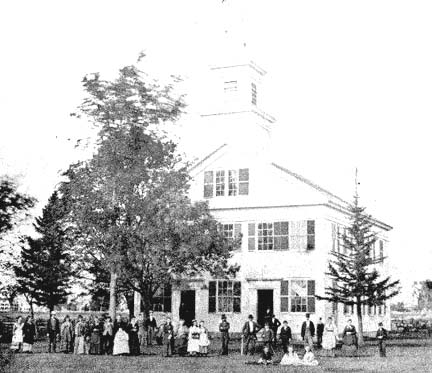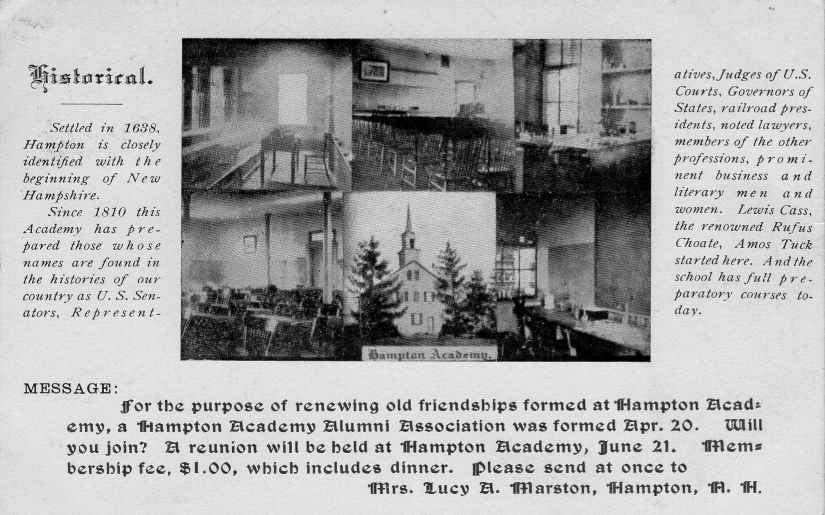By Caroline C. Shea
Hampton Union & Rockingham County Gazette
Thursday, January 30, 1930

[Photo not in original Caroline Shea article.]
The Rev. Josiah Webster was installed as minister of the church in Hampton in 1808, his pastorate lasting until his death in 1837. On the monument marking his grave, from the inscription Mr. Webster is thus characterized: "An exemplary Christian, an impressive and distinguished Preacher, a faithful and affectionate Pastor, a devoted and efficient Friend to the cause of sound learning, to the interests of the Church of God, to the Welfare of his Country and Mankind."
It was this man who first thought of a School for higher learning in the town of Hampton. He found enough of the citizens interested to petition in the General Court for an "Act to incorporate certain persons, by the name of the Proprietary School of Hampton." The persons were: Edmund Toppan, Joseph Towle, Jr., John Fogg, Thomas Ward, Ebenezer Lawrence, Samuel F. Leavitt, Richard Greenleaf, their associates and successors. The Corporation was not to hold real estate exceeding $20,000, no more than $10,000 to be exempt from taxation. This act was approved by the governor the 16th of June 1810. The first $1,000 was raised by 30 men subscribing $25 per share from one to four shares each. In Feb. 1811 further subscriptions were sold. The Town of Hampton gave to the corporation the Green -- where is now Tuck House and grounds -- and which had been the site of the meeting house when Church and Town were one.
Richard Greenleaf took the contract to build, stonework and all, for $738. The building was but one story. In 1820 Rockingham Lodge 34 of Free Masons asked to build an additional story for its own use. In a record of this transaction the school is first called "Academy." This request failed to be granted. Next year however the building was enlarged and the second story put on. Capt. Simon Towle took the contract for $450. 35 more shares were issued at $20 per share. While the work was being done the school was kept in the house of James Leavitt, known later as the Haunted House, or the Moulton House, now owned by Harlan Little.
This year it was proposed that the Proprietors turn everything over to a board of Trustees, the Rev. Jonathan French to elect the board, which was to fill its own vacancies and thus perpetuate itself. He chose 13. The list is interesting. The Rev. Jonathan French, D. D., N. Hampton, James Leavitt Esq., Rev. Josiah Webster, Capt. Edmund James, Maj. John Lovering, Dr. Ebenezer Lawrence, Mr. Josiah Page, Mr. Moody Stockman, Rev. Ephraim Abbott, Greenland, Col. George Weeks, Greenland, Rev. Luther F. Dimmick, D. D., Newburyport, Judge Timothy Farrar, Portsmouth, Francis Vose, ex-officio.
"All rights and interests, privileges and immunities," were turned over to this board. The same day a Constitution already drawn up by the Rev. J. Webster, the Rev, J. French, and Judge Timothy Farrar, was adopted. Extracts from this may be seen in the History of the town. Great stress was put on the choice of the instructorss, that they should be men of high character and religious principles, with all due regard to learning, the disposition of the mind and morals of the pupils was the first to be considered. The Puritan principles of the settler had not become extinct.
English, Greek, Latin, writing, arithmetic, music, the art of speaking; and Geometry, and Liberal Arts and Sciences, and Languages to be introduced as ability and opportunity demanded. It was Mr. Webster's wish that female education be improved. He was appointed agent to get donations, together with Mr. Abbott. The first year they collected $800 and received the gift of 300 acres of land in the town of Peeling, and the next year Mr. Abbott reported gifts of $200; and so little by little enough was obtained for the expenses. Mr. Brackett of Greenland gave a considerable sum provided that his grand children, 4 or 5, received tuition and board, free. He intended to give a fund sufficient to make the school independent, but in old age was prevailed upon to give it to Greenland. Fruitless law suits followed his death, to break the will.
The school prospered and gained a high place in education, notwithstanding nearby well established institutions of learning.
The first Principal was Andrew Mack. He recorded that in Sept. 1811 he set out from Londonderry for Newburyport. That led by the "Unseen Hand which shapes the History of our lives" he arrived in Hampton on the day of a meeting for the Trustees. The meeting was not harmonious. There were 7 Orthodox and 7 Unitarian members. They agreed to chop their differences, however, and took him for the principal, contracting for 3 terms. He had taught in Gilmanton Academy and Dartmouth College. The town History gives a list of his pupils; there were many girls. Later a separate department was instituted in which the female pupils were taught in classes by themselves, with a preceptress. The school flourished, and from year to year young men were fitted for college who afterwards became nationally famous. Among these the sons of Mr. Webster, Amos Morrell, Judge of the U. S. Court of Texas; Daniel Clark, Judge of the U. S. Court of N. Hampshire, U. S. senator; Moses Norris congressman and senator; James F. Joy, railroad king, Gov. of Iowa, Senator; Amos Tuck, member of Congress; and many others of local fame. Rufus Choat finished his course here in 1815.
The early prospectors were men of "learning culture and piety."
In 1837, Mr. Amos Tuck, then principal and trustee proposed the purchase of scientific and chemical apparatus, offering to give up all claim on the income of funds, and depend on his tuitions alone for salary, until there should be enough funds from the income accumulated to pay for the apparatus. This was done at an expense of $3,000. Mr. Timothy Norris taught for the longest time, twelve years.
On Aug. 29, 1851 between one and two in the A. M. the Academy was completely destroyed by fire thought to be incendiary. Prof. T. O. Norris, Rev. S. P. Fay, Josiah Dow, S. B. Shaw, and T. Ward were chosen as a building committee for a new building constructed after its plan. Mr. Norris and Mr. Ward were so zealous in their efforts soliciting funds, and working with their own hands, that the trustees passed a resolution that their names be held in remembrance by all friends of the Academy. The upper story of the new building designed for a hall, was not finished, and ever after the boys and girls were taught together. There were now only a fund of $1045. Ten years later $2000 was received from the estate of Christopher Toppan of Portsmouth; the income to provide the tuition of three boys and three girls for three years and so on in perpetuity. In 1891 Miss Abigail Leavitt left by will the residue of her property to the school, supposed to be at the time about $8000.
In 1827 there were two Literary Societies for the collection of books and improvement in speaking and writing. Their records and library were destroyed in the fire, but it is known that they held weekly meeting and had a debating society.
The old Academy had a great influence in the town. The teachers were men and women of high standing, some of them remaining long enough to become a part of its religious and social life. Young men and women came from other towns, to mingle with the youth of Hampton for mutual good, and for the improvement of all. The programs of the closing exercises in the old days show the high grade of instruction. Greek and Latin dialogues were composed by the boys, those in French by the girls, and original orations were delivered. In the 50's there was a flower garden, that the young ladies might be helped in the study of botany. Pupils from other towns found boarding places at Squire Leavitt's — the old Moulton House - where today their names cut in the woodwork-of the closets may be read. Mrs. David Philbrick, who lived on what is now the Freeman Williams place, was a famous boarding mistress, entertaining some of the students who afterwards became famous men. The writer has the cups and saucers from which they drank their tea. Rufus Choate probably boarded at Parson Webster's. The male students wore calico gowns and carried cloth book bags. Twenty catalogues were issued containing courses of study and prices of tuition and board.
The institution never recovered from the fire; it lost its prestige outside the locality for lack of funds to establish itself, and because of rival schools in nearby towns which were largely endowed. The trustees always endeavored to obtain good instructors and to help them in every way to get pupils and such supplies as they could. In the '70's and longer the tuition for English branches was $5 per term, for one language either French or Latin $6; for both $7. The principal was obliged to depend on these fees and the tuitions of scholars paid for by the income of funds. They found their food and one of the older male pupils used the building and built the fire for his tuition. The girls were not above doing some of the sweeping and dusting necessary. There were no sports except for the baseball which the boys played in the Green now the Memorial Park; and for a time there was a croquet set for the girls — and boys too if they cared to play.
In 1872 it was voted to establish a high school. Plans were made, but on account of opposition, were not completed. In 1881 the late Christopher Toppan gave the acre of land where the Academy now stands; and in 1883 the building was moved to that site "by 80 yoke of oxen and several pairs of horses attached in four strings to heavy cables" from Portsmouth Navy yard. The first start it moved only a few feet. In seventeen minutes from the second start, it stood proudly on the new site, nearly a half mile distant, amid the ringing of bells and vociferous cheers of the populace." In 1883 after necessary repairs the school which had been closed for 3 years again opened. In 1885 it began to function as Hampton Academy and High School. But that is another story.
The History of the Academy has always been honorable. As a local institution it has been fairly prosperous and has sent forth many to special or higher schools and to college, who have become reputable and distinctive citizens in their own and other communities. Only time can disclose its future. Its usefulness has been augmented by the Tuck Athletic field and Playground, coming through the generosity of Mr. Edward Tuck of Paris, who as was his father before him, has always been a help and a benefactor to the Academy. Again as of old should the Trustees pass a resolution: "that their names be held in grateful rememberance by all the friends of Hampton Academy."

